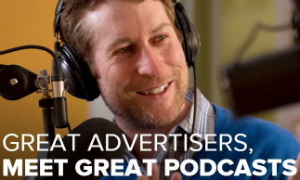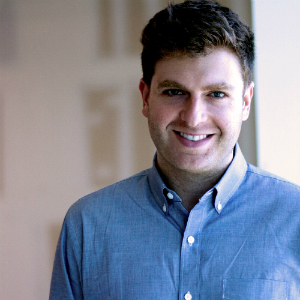 Two weeks ago podcast production and distribution company Earwolf merged with The Midroll, a podcast advertising agency spawned from Earwolf’s monetization efforts, to form Midroll Media. RAIN spoke with new Midroll Media CEO Adam Sachs about the merger’s values, how podcast ads are sold, and the future of on-demand talk programming.
Two weeks ago podcast production and distribution company Earwolf merged with The Midroll, a podcast advertising agency spawned from Earwolf’s monetization efforts, to form Midroll Media. RAIN spoke with new Midroll Media CEO Adam Sachs about the merger’s values, how podcast ads are sold, and the future of on-demand talk programming.
Sachs emphasized that Midroll Media’s unique stance in the industry is its support of the art, craft, and livelihood of podcasters. “What’s important about the merger is that it brings a certain capabilities from Earwolf. We care most about the podcaster and making money for podcasters, allowing them creative freedom to make their art, and getting them compensated fairly for it. We are hired by the podcasters.”
Midroll Media is the sole advertising representative for over 125 programs on its platform. Adam Sachs said the business grew as a natural evolution from a small starting point.
“Our ad sales developed in a completely organic way. It was podcasters wanting to monetize their craft, and not knowing how to do it. Jeff Ullrich [Earwolf founder], our previous CEO and current chairman, is a podcaster himself. At Earwolf they they wanted to monetize Comedy Bang Bang first, and do it in a way that was podcaster-friendly. Jeff’s friends in the podcaster community came to him, asking if he could sell ads for their programs, too. Marc Maron was one of those. Jeff started doing it almost as a favor, then realized it was a real business. What makes Midroll Media special, is that it’s born out of Earwolf, and the perspective of podcasters. Our head of sales has three active podcasts.”
“Some of the other agencies out there are the agencies of record for the advertiser. Our fiduciary duty is to the podcaster.” –Adam Sachs, CEO, Midroll Media
Sachs talked about “podcaster-driendly” advertising, and we asked him what that meant. He said that podcasters make the decisions about how many ads to put in their programs, and they have rejection rights over advertisers.
“All of our ads are read by the host. The host is endorsing the product or service. We don’t want them to do that unless we feel they can genuinely endorse the product. If a podcaster says, ‘Nope, I don’t believe in that product or service, I don’t want to read that spot,’ we don’t ask why or argue — we allow full veto right.”
 In the unique realm of podcasting, ratings and consumption metrics can be confusing. Midroll Media sells ad inventory on the basis of downloads — which is identical to streaming, since both modes of listening hit the server in the same way. Midroll gives the prospective advertiser a forecast based on historical tracking, which Sachs says is usually accurate. “If the forecast is below actual downloads, the advertiser gets a good deal. If the downloads are lower than the forecast, we do what it takes to make it right for the advertiser.”
In the unique realm of podcasting, ratings and consumption metrics can be confusing. Midroll Media sells ad inventory on the basis of downloads — which is identical to streaming, since both modes of listening hit the server in the same way. Midroll gives the prospective advertiser a forecast based on historical tracking, which Sachs says is usually accurate. “If the forecast is below actual downloads, the advertiser gets a good deal. If the downloads are lower than the forecast, we do what it takes to make it right for the advertiser.”
We were curious about the barrier to entry for podcasters. How big an audience is needed to get on Midroll Media’s platform, and how many listeners are required for effective monetization? Adam Sachs told us it depends on how the show, and the advertiser, are targeted.
“We have some shows that are laser-focused on a particular audience. In that case, even a smaller audience can be monetized, because advertisers say, ‘Wow, if I advertise on this tech (for example) show, I can reach a targeted audience interested in my product or service, and I don’t want to reach everybody else.’ If it’s a broader audience, like comedy, we now typically take on shows that have 50,000 downloads per episode, or more.”
Selling inventory across programs can increase value to the advertiser, but must be done smartly. “For the most part we build ad campaigns based on specific shows,” Sachs said. “An advertiser might want to reach a comedy audience, but mostly male, and perhaps in a certain age group — we have demographic data that we can use for a proposal. So we might say, ‘Here are six shows, in this time period.’ The buys are usually across multiple shows, not a single show, but usually not run-of-network. Advertisers don’t say: ‘Here’s $10,000; spray it across the network.'”
Midroll Media employs three sales people, two campaign managers, and an artist-care expert who prepares the podcaster with ad copy and reviews the performance.
Surveying the podcast industry, Adam Sachs rattled off research statistics citing growth of podcast listening. (Edison Research’s The Infinite Dial 2014 revealed that podcast listening reached a new high in 2013, with 30% of U.S. adults having heard a podcast, 39-million users per month, and 205 of those people consuming at least six podcasts per week.) Sachs told us that digital dashboards in Internet-connected cars would fuel mobile growth.
“The proliferation of 4G in cars, which in a few years will be nearly all cars, will make podcast listening in the car much easier. Apple’s in-car operating system [CarPlay] is huge. The podcast app is going to be native in the new iPhone [it will be included as a default app], and our hope is, that will be the case in [Apple-enabled] cars, too.”

